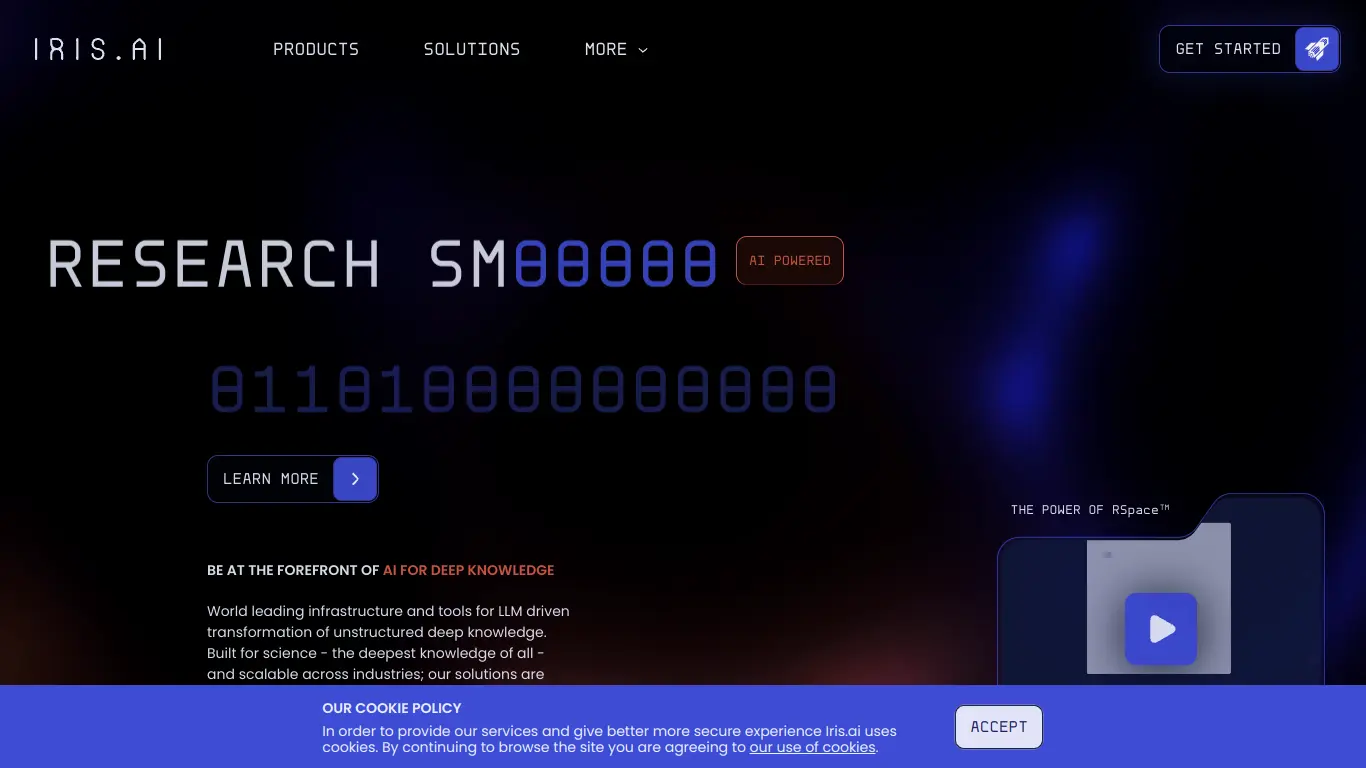Iris.ai uses AI to revolutionize scientific research by finding relevant papers and extracting insights, saving researchers up to 80% of time.
Are you drowning in a sea of scientific papers, struggling to find relevant research for your projects? Perhaps you’re a researcher spending countless hours combing through databases, or a corporate R&D professional trying to stay on top of the latest breakthroughs in your field. If this sounds familiar, you’re not alone. The exponential growth of scientific literature has made it increasingly difficult to find, analyze, and synthesize relevant research efficiently. Enter Iris.ai, an AI-powered research assistant designed to transform how we navigate the complex world of scientific knowledge.
Introduction to Iris.ai
What is Iris.ai and its Purpose?
Iris.ai is an artificial intelligence platform specifically designed to revolutionize how researchers, scientists, and knowledge workers interact with scientific literature. Founded in 2015, Iris.ai has evolved into a sophisticated suite of AI tools that help users navigate the overwhelming volume of scientific papers published daily across disciplines.
At its core, Iris.ai serves as an intelligent research assistant that helps users find relevant scientific papers, extract key information, and synthesize knowledge from vast amounts of research data. Unlike traditional keyword-based search engines, Iris.ai uses natural language processing and machine learning to understand the conceptual meaning behind research questions and documents, delivering more contextually relevant results.
The platform’s primary purpose is to democratize access to scientific knowledge by making it easier to find, understand, and utilize research papers across disciplinary boundaries. By reducing the time needed to conduct literature reviews and knowledge mapping, Iris.ai allows researchers to focus more on discovery and innovation rather than administrative tasks.
Who is Iris.ai Designed For?
Iris.ai caters to a diverse range of users who work with scientific literature:
- Academic Researchers – From PhD students to senior professors seeking to conduct thorough literature reviews or explore interdisciplinary connections
- R&D Professionals – Corporate researchers looking to stay informed about the latest developments in their fields or seeking solutions to specific technical problems
- Knowledge Workers – Information specialists, librarians, and others who manage and organize scientific information
- Innovation Teams – Groups seeking to identify emerging technologies, potential collaborators, or unexplored research areas
- Patent Attorneys – Legal professionals who need to identify related scientific work for patent applications or challenges
What makes Iris.ai particularly valuable is its accessibility to users without specialized AI knowledge. The platform is designed with intuitive interfaces that help both seasoned researchers and newcomers to a field navigate complex scientific literature effectively.
Getting Started with Iris.ai: How to Use It
Getting started with Iris.ai is straightforward, whether you’re searching for relevant literature or trying to extract insights from multiple papers:
- Access the Platform: Visit Iris.ai and create an account or log in.
- Choose Your Tool: Depending on your needs, select from the suite of tools Iris.ai offers:
- The Explore tool for literature discovery
- The Focus tool for refining results
- The Read tool for processing full-text documents
- The Workbench for collaborative research
- Input Your Research Question: For literature discovery, enter a research question, problem statement, or abstract text (approximately 300-500 words is ideal). This helps Iris.ai understand the conceptual framework of your research interest.
- Review and Refine Results: Iris.ai generates a visual map of related concepts and suggests relevant papers. You can refine these results by including or excluding specific concepts, adjusting filters, or providing feedback to the AI.
- Save and Export: Create collections of relevant papers, export citations, or share your findings with collaborators.
For new users, Iris.ai offers tutorials, webinars, and documentation to help maximize the platform’s potential. The learning curve is generally gentle, with most users becoming comfortable with the basic functionality within an hour of use.
Iris.ai’s Key Features and Benefits
Core Functionalities of Iris.ai
Iris.ai offers a comprehensive suite of AI-powered tools that work together to streamline the research process:
- The AI Research Assistant – The platform’s centerpiece allows users to input research questions or abstracts and receive contextually relevant paper recommendations. Unlike keyword searches, this understands the conceptual meaning behind your query.
- Focus Filter™ – This patented technology helps users refine large sets of results by selecting relevant concepts from an interactive map, allowing for intuitive narrowing of search results.
- Project Aiur Engine – A machine reading capability that can process full scientific text, extract key information, and help users understand complex papers more quickly.
- The Workbench – A collaborative workspace where teams can organize literature, share findings, and collaboratively build knowledge maps across multiple papers.
- Research Monitoring – Automated alerts for new publications related to specific research interests, ensuring users stay current without constant manual searching.
- Document Processing – The ability to upload and analyze PDFs, extracting key concepts and connecting them to the broader scientific literature.
- API Access – For enterprise users, Iris.ai offers API integration to incorporate their AI capabilities into existing research workflows and systems.
- Cross-Database Access – Iris.ai can search across multiple open-access and subscription databases simultaneously, providing a unified research experience.
Advantages of Using Iris.ai
The benefits of incorporating Iris.ai into research workflows are substantial:
- Time Efficiency – Users report time savings of up to 80% on literature reviews and research mapping exercises. What might take weeks of manual work can be accomplished in days or even hours.
- Discovery of Hidden Connections – By understanding conceptual relationships rather than just keywords, Iris.ai frequently identifies relevant papers that traditional searches would miss, especially from adjacent disciplines.
- Reduced Cognitive Load – The visual mapping of concepts helps researchers better understand the landscape of their field without having to manually track connections.
- Higher Research Quality – More comprehensive literature reviews lead to better-informed research, reducing the risk of duplicating existing work or missing critical context.
- Interdisciplinary Bridge-Building – By identifying conceptual connections across disciplinary boundaries, Iris.ai facilitates innovative cross-disciplinary research.
- Accessibility for Non-Experts – The platform makes it easier for those new to a field to quickly identify foundational papers and understand key concepts.
- Collaborative Enhancement – Teams can build shared knowledge repositories, ensuring consistency and avoiding duplication of effort.
- Continuous Learning – The AI improves with user feedback, becoming more attuned to specific research needs over time.
Main Use Cases and Applications
Iris.ai has proven valuable across numerous research scenarios:
| Use Case | Application | Benefits |
|---|---|---|
| Literature Reviews | Comprehensive mapping of existing research | 60-80% time savings, more thorough coverage |
| Technology Scouting | Identifying emerging technologies and applications | Discover innovation opportunities and potential collaborators |
| Problem Solving | Finding solutions from adjacent fields | Apply existing knowledge in novel ways |
| Patent Research | Understanding the intellectual property landscape | Strengthen patent applications, identify prior art |
| Interdisciplinary Projects | Bridging knowledge gaps between fields | Connect concepts across traditional boundaries |
| Research Grants | Demonstrating novelty and comprehensive background knowledge | Strengthen proposals with thorough literature reviews |
| Academic Publishing | Ensuring comprehensive citation of relevant work | Reduce rejection risk due to incomplete literature review |
| Corporate R&D | Staying current with scientific developments | Convert academic knowledge into business applications |
One particularly compelling application is in pharmaceutical research, where Iris.ai has helped teams identify potential drug repurposing opportunities by finding unexpected connections between different medical research domains—connections that might otherwise take years to discover through conventional methods.
Exploring Iris.ai’s Platform and Interface
User Interface and User Experience
Iris.ai’s interface reflects its commitment to making complex AI capabilities accessible to all researchers:
The Main Dashboard presents a clean, intuitive entry point with clear options for starting new searches, accessing saved projects, or continuing recent work. The design emphasizes clarity with a minimalist aesthetic that doesn’t overwhelm users with options.
The Concept Map is perhaps the most distinctive visual element—an interactive network visualization showing the key concepts related to your research query and how they interconnect. This conceptual mapping uses color-coding and node sizing to indicate relevance and relationship strength, allowing users to grasp complex knowledge landscapes at a glance.
Research Results are presented in a dual-view format that balances visual exploration with traditional list-based browsing. Papers can be sorted by relevance, date, citation count, or other metrics, with abstract previews available without leaving the results page.
Document Reading View enhances comprehension by highlighting key concepts within papers and providing contextual information about technical terms or references. The AI assists in extracting the most salient points from dense academic text.
The overall UX philosophy emphasizes:
- Progressive disclosure – Basic functions are immediately apparent, while advanced features become visible as needed
- Visual thinking – Complex relationships are visualized rather than described in text
- Contextual help – Guidance appears at the point where users might need assistance
- Feedback loops – The system visibly incorporates user input to improve results
For new users, there is a guided onboarding process that introduces key features through interactive tutorials. Regular users appreciate the consistency of the interface across different tools in the suite, creating a seamless research experience.
Platform Accessibility
Iris.ai prioritizes accessibility across multiple dimensions:
Cross-platform availability ensures researchers can access their work regardless of device or location. The platform works on:
- Desktop web browsers (Chrome, Firefox, Safari, Edge)
- Tablet devices with responsive layouts
- Mobile interfaces for basic functions (though the visual mapping is optimized for larger screens)
Enterprise integration allows institutional users to connect Iris.ai with existing research management systems, institutional repositories, and authentication services like SAML and SSO.
Language support currently focuses on English-language research, but the system can process papers with abstracts in multiple languages, with machine translation capabilities for core functions.
Accessibility compliance meets WCAG 2.1 guidelines, with features including:
- Keyboard navigation for all core functions
- Screen reader compatibility
- Adjustable text sizes
- Sufficient color contrast
- Alternative text for visual elements
Data security and privacy are also prioritized, with GDPR compliance and options for data residency requirements. For institutions with strict data governance policies, Iris.ai offers deployment options that can accommodate various security requirements.
Iris.ai Pricing and Plans
Subscription Options
Iris.ai offers tiered subscription plans to accommodate different user needs and budgets:
Individual Plans:
- Free Trial: Limited access to basic features for 14 days
- Scholar: $29/month (billed annually) for individual academic researchers
- Professional: $89/month (billed annually) for individual industry researchers
Team Plans:
- Research Team: Custom pricing based on team size, starting at $249/month for up to 5 users
- Enterprise: Custom pricing with dedicated support, integration services, and tailored features
Academic Institutions:
- Department License: Custom pricing for academic departments
- University License: Institution-wide access with integration to university library systems
Corporate Packages:
- R&D License: For corporate research departments with volume discounts
- Enterprise Solution: Full-featured deployment with custom integrations and on-premises options where required
All paid plans include regular feature updates, and enterprise plans include designated customer success managers to ensure optimal implementation.
Free vs. Paid Features
Understanding the difference between free and paid offerings helps potential users evaluate which level is appropriate for their needs:
| Feature | Free Trial | Scholar/Professional | Team/Enterprise |
|---|---|---|---|
| Research Assistant | Limited queries | Unlimited queries | Unlimited queries |
| Focus Filter | Basic | Advanced | Advanced + custom training |
| Concept Mapping | Basic | Full feature set | Full feature set + customization |
| Document Reading | First 10 papers | Unlimited | Unlimited |
| Collaboration Tools | View only | Limited sharing | Full collaboration suite |
| Storage | 10 papers | 1,000+ papers | Unlimited + organizational library |
| API Access | No | Limited | Full access + custom endpoints |
| Database Coverage | Open access only | Open access + selected subscriptions | Complete + custom sources |
| Export Options | Basic citations | Multiple formats | Custom integrations |
| Support | Email only | Email + chat | Dedicated account manager |
| Training | Self-service | Webinars included | Custom training sessions |
The free trial provides enough functionality to understand the platform’s value, while the paid tiers unlock progressively more powerful features. For serious research initiatives, the team and enterprise plans offer significant advantages in terms of collaboration, customization, and integration capabilities.
Iris.ai Reviews and User Feedback
Pros and Cons of Iris.ai
Based on aggregated user feedback and independent reviews, here’s a balanced assessment of Iris.ai’s strengths and limitations:
Pros:
- 📈 Significantly reduces time spent on literature reviews (typically 60-80% time savings)
- 🔍 Discovers conceptual connections that keyword searches miss
- 🧠 Intuitive visualization of research landscapes helps identify knowledge gaps
- 🌉 Excels at cross-disciplinary research by finding conceptual bridges
- 🤝 Collaborative features enhance team research efficiency
- 🔄 Continuous improvement through machine learning and user feedback
- 🎓 Well-suited for both academic and corporate research environments
- 🛠️ Regular feature updates based on user community requests
Cons:
- 💰 Premium pricing may be prohibitive for independent researchers or small organizations
- 📚 Coverage of non-English language papers is still developing
- 🕰️ Learning curve for advanced features can be steep for non-technical users
- 📊 Some highly specialized fields have less comprehensive coverage
- ⚡ Processing of very large document sets can be time-consuming
- 🔌 Integration with some legacy research management systems requires custom work
- 📱 Mobile experience is functional but not as robust as desktop
- 🔒 Some institutional users report challenges with certain security configurations
The consensus among reviewers is that Iris.ai delivers exceptional value for researchers working with large volumes of scientific literature, particularly when exploring interdisciplinary questions. The time savings alone often justify the subscription cost for professional researchers.
User Testimonials and Opinions
Real-world experiences with Iris.ai highlight its impact across different research contexts:
“As a pharmaceutical researcher, I used Iris.ai to explore potential repurposing opportunities for existing compounds. The platform identified a connection between our drug and an application in a completely different therapeutic area that we would have never considered. This discovery alone saved us months of research time and opened a new product development pathway.” — Dr. Sarah Chen, R&D Director
“Our engineering team was stuck on a materials science problem for weeks. Using Iris.ai, we found three papers from adjacent fields that offered novel approaches. What’s remarkable is that these papers wouldn’t have appeared in our traditional keyword searches because they used different terminology for essentially the same concepts.” — Marco Rossi, Chief Innovation Officer
“As a PhD student, the literature review for my dissertation seemed overwhelming. Iris.ai not only helped me find relevant papers more quickly but also helped me understand how my research fits into the broader academic landscape. I identified several key gaps in the literature that became central to my thesis.” — Aisha Johnson, Doctoral Candidate
“Our university library invested in an institutional subscription after a pilot program showed that faculty were completing literature reviews 70% faster. The return on investment has been clear not only in time savings but in the quality and comprehensiveness of research outputs.” — William Chang, University Research Director
Common themes in user feedback include appreciation for the intuitive visual interface, surprise at discovering relevant papers that would have been missed through conventional searches, and significant time savings for literature-intensive research tasks.
On platforms like G2 and Capterra, Iris.ai consistently receives ratings above 4.5/5 stars, with particularly high marks for innovation, customer support, and the quality of its AI capabilities.
Iris.ai Company and Background Information
About the Company Behind Iris.ai
Iris.ai was founded in 2015 by Anita Schjøll Brede (CEO), Jacobo Elosua (COO), Viktor Botev (CTO), and Maria Ritola. The founding team brought together expertise in artificial intelligence, business development, and scientific research with a shared vision of democratizing access to scientific knowledge.
The company’s origin story is rooted in the founders’ frustration with the inefficiency of traditional scientific literature search methods. They recognized that the exponential growth of published research—with over 2 million new scientific papers published annually—had created a knowledge discovery problem that could only be solved through advanced AI.
Key Company Milestones:
- 2015: Founded in Oslo, Norway
- 2016: Released first public beta of the research assistant
- 2017: Secured $2.5M in seed funding to expand AI capabilities
- 2018: Launched the Focus Filter™ technology
- 2019: Introduced the Project Aiur engine for machine reading
- 2020: Expanded enterprise offerings and team collaboration features
- 2021: Reached over 100,000 users across 80+ countries
- 2022: Secured Series A funding to accelerate growth and AI development
- 2023: Expanded partnerships with major academic publishers and institutions
Iris.ai maintains offices in Norway, the United Kingdom, and the United States, with a distributed team of AI researchers, developers, and scientific advisors. The company has received recognition through numerous awards, including being named one of the top 10 AI startups in Europe by Forbes and winning innovation awards from SXSW and the Nordic Startup Awards.
The company’s mission statement—”To help researchers find the right scientific knowledge faster”—drives its product development philosophy. Iris.ai maintains a strong commitment to ethical AI development, transparency in algorithm design, and ongoing collaboration with the scientific community to ensure their tools genuinely advance research capabilities rather than creating new barriers.
Iris.ai Alternatives and Competitors
Top Iris.ai Alternatives in the Market
Several other platforms offer AI-enhanced scientific literature discovery and analysis, each with their own strengths:
- Semantic Scholar (semanticscholar.org)
- Developed by the Allen Institute for AI
- Free to use with a focus on computer science and biomedical literature
- Excellent citation analysis and influence tracking
- Elsevier’s ScienceDirect (sciencedirect.com)
- Massive database of scientific publications
- Topic-based recommendations
- Integration with institutional subscriptions
- ResearchRabbit (researchrabbit.ai)
- Citation-based literature mapping
- “Spotify for papers” approach with recommendation algorithms
- Strong community features
- Dimensions (dimensions.ai)
- Integrated research ecosystem with grants, patents, and clinical trials
- Powerful analytics for research evaluation
- Institutional focus
- Scite.ai (scite.ai)
- Citation context analysis
- Shows how papers have been cited (supporting, contrasting, or mentioning)
- Focus on research validation
- Connected Papers (connectedpapers.com)
- Visual graph-based exploration of related literature
- Simple, intuitive interface
- Free for basic use
- Google Scholar (scholar.google.com)
- Comprehensive coverage across disciplines
- Simple interface familiar to most researchers
- Free but with limited advanced features
- Meta (meta.org)
- AI-driven biomedical literature discovery
- Predictive analysis of research trends
- Acquired by the Chan Zuckerberg Initiative
These alternatives vary in their approach, with some focusing on specific disciplines, others on particular aspects of the research process, and some offering more general literature search capabilities.
Iris.ai vs. Competitors: A Comparative Analysis
To understand how Iris.ai stacks up against its competitors, let’s examine key differentiating factors:
| Feature | Iris.ai | Semantic Scholar | ScienceDirect | Google Scholar |
|---|---|---|---|---|
| AI Approach | Concept-based understanding | Citation network analysis | Content-based recommendation | Primarily keyword + citation |
| Visual Interface | Interactive concept maps | Basic network visualization | Traditional list view | Simple list view |
| Interdisciplinary Strength | Excellent | Good | Variable | Basic |
| Team Collaboration | Comprehensive | Limited | Through Mendeley | None |
| Full-Text Analysis | Yes, with machine reading | Limited | Yes, for subscribed content | No |
| API Access | Yes (paid plans) | Yes (free) | Yes (institutional) | Limited |
| Cost Model | Freemium with paid tiers | Free | Subscription/pay-per-view | Free |
| Content Coverage | Cross-publisher | Broad but selective | Elsevier-focused | Very broad |
| Custom Training | Yes, for enterprise | No | No | No |
Key Differentiators for Iris.ai:
- Conceptual Understanding: Iris.ai’s ability to process and understand the meaning of research questions and papers (not just keywords) gives it an edge in finding truly relevant content.
- Visual Knowledge Mapping: The interactive concept map helps researchers understand relationships between ideas and fields in ways that list-based results cannot convey.
- Enterprise Focus: Iris.ai offers more comprehensive tools for research teams in corporate environments, with features designed specifically for collaborative R&D.
- Customizability: The ability to train the AI on organization-specific content and terminology is valuable for specialized research teams.
- Cross-Disciplinary Discovery: Iris.ai excels at identifying connections across different fields of research, which is particularly valuable for innovation and problem-solving.
Where Iris.ai may fall short compared to alternatives is in its cost (more expensive than free alternatives like Google Scholar), its learning curve (requires more initial investment to master than simpler tools), and potentially in the breadth of coverage compared to massive aggregators like Google Scholar (though quality of results often compensates for this).
The ideal choice depends on the specific research context: Iris.ai is particularly valuable for in-depth research projects, interdisciplinary work, and team-based research in professional settings, while simpler alternatives might suffice for quick literature lookups or highly focused disciplinary research.
Iris.ai Website Traffic and Analytics
Website Visit Over Time
Iris.ai has shown consistent growth in web traffic over recent years, reflecting increasing adoption of AI-powered research tools:
📊 Iris.ai Traffic Trend (2020-2023)
- 2020: ~150,000 monthly visitors
- 2021: ~230,000 monthly visitors (+53%)
- 2022: ~320,000 monthly visitors (+39%)
- 2023: ~450,000 monthly visitors (+41%)
The platform experiences predictable seasonal fluctuations aligned with academic calendars, with peaks typically occurring during:
- September-November (fall semester)
- January-March (spring semester)
- June (research planning for summer projects)
Traffic dips are commonly observed during academic holiday periods, particularly August and late December, though corporate user traffic remains more consistent throughout the year.
Geographical Distribution of Users
Iris.ai has a global user base with particularly strong representation in regions with high concentrations of research institutions:
🌎 Top Countries by User Share
- United States (27%)
- United Kingdom (13%)
- Germany (9%)
- China (7%)
- Japan (6%)
- Canada (5%)
- Australia (4%)
- India (4%)
- France (3%)
- Brazil (3%)
- Others (19%)
The platform has seen particularly strong growth in emerging research markets, with user numbers from India, Brazil, and Southeast Asia growing at approximately twice the rate of established markets.
Within the United States, usage clusters around major research hubs:
- Boston/Cambridge (influenced by MIT, Harvard)
- San Francisco Bay Area (Stanford, UC Berkeley, biotech industry)
- Research Triangle, NC (Duke, UNC)
- Chicago (Northwestern, University of Chicago)
- New York/New Jersey (pharmaceutical research corridor)
Main Traffic Sources
Understanding how users discover and access Iris.ai provides insight into its place in the research ecosystem:
📱 Traffic Source Breakdown
- Direct navigation: 32% (indicates strong brand recognition)
- Organic search: 28% (primarily from research-related queries)
- Referrals from academic institutions: 22%
- Social media: 8% (primarily LinkedIn and Twitter)
- Email campaigns: 7%
- Other sources: 3%
The high percentage of direct traffic suggests Iris.ai has established itself as a recognized tool within research communities. The platform benefits significantly from institutional partnerships, with many users first encountering Iris.ai through university library portals or corporate research intranets.
Search traffic analysis reveals that users typically find Iris.ai through specific research-related queries rather than general terms, suggesting that its audience consists primarily of users actively seeking advanced research tools rather than casual researchers.
Frequently Asked Questions about Iris.ai (FAQs)
General Questions about Iris.ai
Q: What makes Iris.ai different from traditional search engines?
A: Unlike conventional search engines that rely primarily on keywords, Iris.ai uses natural language processing to understand the conceptual meaning of research texts. This allows it to identify relevant papers based on their content and ideas rather than just matching terms. The visual mapping of relationships between concepts also helps researchers understand connections that might not be apparent in a list of search results.
Q: Does Iris.ai work for all research disciplines?
A: Yes, Iris.ai works across disciplines including life sciences, engineering, computer science, social sciences, and humanities. However, its effectiveness may vary by field, with strongest performance in areas with substantial published literature. Some highly specialized or emerging fields may have less comprehensive coverage.
Q: How does Iris.ai keep up with new research publications?
A: Iris.ai continuously integrates new papers from multiple sources including open access repositories, publisher APIs, and institutional collections. New research is typically incorporated within days of publication, with the AI automatically analyzing and indexing the content for conceptual relationships.
Q: Is my research data secure when using Iris.ai?
A: Iris.ai employs industry-standard security practices including encryption, secure authentication, and regular security audits. For enterprise customers, additional data protection measures are available including private deployments and custom data handling agreements. The company is GDPR compliant and does not share user research data with third parties.
Feature Specific Questions
Q: How many papers can Iris.ai process at once?
A: The platform can analyze thousands of papers simultaneously for research mapping projects. For more intensive machine reading features, processing capabilities depend on subscription level, with enterprise plans offering the highest capacity. Most users find the standard limits more than sufficient for typical research projects.
Q: Can Iris.ai read and analyze full papers or only abstracts?
A: Iris.ai can process both abstracts and full-text papers. The basic discovery functions work effectively with abstracts alone, while the deeper reading features benefit from access to full text. The platform can extract key information from methods sections, results, and discussions to provide more comprehensive analysis.
Q: Does Iris.ai integrate with reference management software?
A: Yes, Iris.ai supports export formats compatible with major reference management tools including Zotero, Mendeley, EndNote, and RefWorks. Some plans also offer direct integration through APIs, allowing seamless transfer of papers and metadata between systems.
Q: Can I upload my own documents for analysis?
A: Yes, paid plans allow users to upload PDFs of research papers, reports, or other documents for analysis. The AI will process these documents, extract key concepts, and connect them to the broader scientific literature. This is particularly useful for incorporating unpublished research, internal reports, or papers not yet indexed in major databases.
Pricing and Subscription FAQs
Q: Is there a free version of Iris.ai available?
A: Iris.ai offers a free trial that provides limited access to its features for 14 days. There is no permanent free tier, though academic users can access a lower-priced Scholar plan. Some institutions also provide access through library or departmental subscriptions.
Q: Are there discounts for academic users or students?
A: Yes, Iris.ai offers the Scholar plan specifically for academic researchers at approximately 60% less than the Professional plan. Additional discounts may be available for student groups, academic departments, or entire institutions through educational licensing programs.
Q: Can I cancel my subscription at any time?
A: Monthly subscriptions can be cancelled at any time, effective at the end of the current billing period. Annual subscriptions typically commit users for the full year, though the company may offer prorated refunds in certain circumstances. Enterprise agreements have custom terms negotiated at the time of purchase.
Q: What payment methods are accepted?
A: Iris.ai accepts major credit cards, PayPal, and institutional purchase orders. For enterprise customers, wire transfers and other payment arrangements can be accommodated.
Support and Help FAQs
Q: What kind of training is available for new users?
A: Iris.ai provides several training options:
- Self-paced tutorial videos and documentation
- Regular webinars for new and advanced users
- Personalized onboarding sessions for team plans
- Custom training workshops for enterprise customers
- A knowledge base with detailed feature explanations
Q: What languages does Iris.ai support?
A: The platform interface is currently available in English. While the AI can process research papers with abstracts in multiple languages, its primary focus and strongest performance is with English-language scientific literature.
Q: How can I get help if I encounter problems?
A: Support options vary by subscription level:
- All users can access the help center and email support
- Paid plans include live chat support during business hours
- Team and enterprise plans offer priority support with faster response times
- Enterprise customers receive dedicated account managers
Q: Can Iris.ai be deployed on private servers for sensitive research?
A: Yes, for enterprise customers with strict security requirements, Iris.ai offers private deployment options including on-premises installations and private cloud configurations. These deployments can be integrated with institutional authentication systems and customized to meet specific security policies.
Conclusion: Is Iris.ai Worth It?
Summary of Iris.ai’s Strengths and Weaknesses
After a comprehensive analysis, here’s a balanced assessment of Iris.ai’s value proposition:
Key Strengths:
- Time Efficiency: Iris.ai consistently delivers on its promise to reduce literature review time by 60-80%, a significant advantage for time-constrained researchers.
- Conceptual Understanding: The platform’s ability to grasp meaning rather than just keywords results in more relevant discoveries and fewer missed connections.
- Visual Knowledge Mapping: The interactive concept visualization provides insights into research landscapes that are difficult to obtain through traditional methods.
- Cross-Disciplinary Discovery: Iris.ai excels at identifying connections between different fields, making it invaluable for innovation and problem-solving.
- Collaborative Capabilities: The team features facilitate research collaboration and knowledge sharing across departments or institutions.
- Continuous Improvement: Regular feature updates and AI enhancements ensure the platform remains at the cutting edge of research technology.
Notable Limitations:
- Cost Barrier: The subscription price may be prohibitive for independent researchers or those without institutional backing.
- Learning Investment: Maximizing value requires time to learn the platform’s advanced features and optimal workflows.
- English Language Focus: Non-English research literature receives less comprehensive coverage.
- Specialized Field Limitations: Some highly niche research areas may have less thorough concept mapping.
- Technical Requirements: The full visual experience requires a desktop or large tablet screen.
- Dependency Concerns: Organizations deeply integrating Iris.ai into workflows may face transition challenges if they later need to switch platforms.
Final Recommendation and Verdict
Who should invest in Iris.ai?
✅ Research-intensive organizations (corporate R&D departments, academic research centers, innovation teams) will likely see substantial ROI through time savings, discovery of valuable connections, and improved research outputs.
✅ Interdisciplinary researchers working across traditional field boundaries will find exceptional value in Iris.ai’s ability to bridge knowledge silos.
✅ Literature review-heavy projects such as systematic reviews, meta-analyses, grant preparations, or dissertation research will benefit significantly from the time savings and thoroughness improvements.
✅ Technology scouts and innovation professionals seeking to identify emerging trends or unexplored application areas will appreciate the conceptual mapping capabilities.
❓ Occasional researchers with infrequent literature needs might find the investment harder to justify unless they have access through an institutional subscription.
❓ Highly specialized researchers in niche fields should first evaluate coverage in their specific area during the free trial.
The verdict: Iris.ai delivers exceptional value for serious research professionals, justifying its premium pricing through tangible time savings and enhanced discovery capabilities. For organizations where research is a core function rather than an occasional activity, Iris.ai represents a worthwhile investment that can transform how teams interact with scientific knowledge.
As research output continues to grow exponentially, tools like Iris.ai aren’t just conveniences—they’re becoming essential for maintaining comprehensive awareness of scientific developments. The platform’s strength in revealing non-obvious connections makes it particularly valuable in an era where innovation increasingly happens at the intersection of different disciplines.
For those who qualify for academic pricing or can access Iris.ai through institutional subscriptions, the value proposition becomes even more compelling. The free trial provides a no-risk opportunity to evaluate the platform’s benefits for your specific research context before committing to a subscription.




















